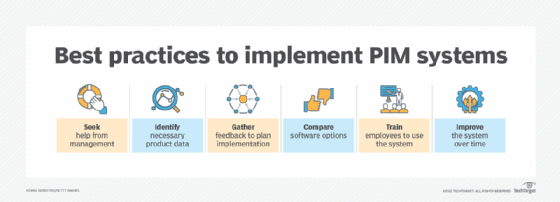
Getty Images/iStockphoto
6 product information management best practices
PIM systems maintain accurate product data across channels. For a successful implementation, business leaders should identify their needs and compare software products.
With many different customer touchpoints popping up, sales and marketing teams can easily send mixed messages to customers, which can negatively affect sales.
However, organizations can use product information management (PIM) systems to improve the coherence, simplicity and effectiveness of their sales and marketing efforts. PIM systems organize and manage the lifecycle of product data, such as technical specifications, media assets, metrics, customer feedback and digital catalog data. To implement a PIM system successfully, e-commerce leaders need management support, defined information requirements and should work alongside sales and marketing teams.
The following best practices can help e-commerce organizations successfully implement a PIM system.
1. Get management team's support
First, PIM advocates need support from their organization's management teams. If managers engage in the PIM system implementation process from the beginning, they can ensure the digital transformation project aligns with business goals.
2. Define information requirements
E-commerce leaders should work with one or two managers from the sales and marketing departments and engage with their teams to define product information requirements. To determine those requirements, they should consider the following questions:
- Do the products have a lot of complex specifications?
- Do they have multiple variants?
- Which comments from happy customers or product reviews could help the platform stand out?
E-commerce leaders must gather all relevant product data, such as technical specifications, digital media assets, usage metrics, testimonials and digital catalog data, to store in the PIM system.
3. Create an implementation plan
A successful PIM system implementation uses sales and marketing content to drive customers to its e-commerce site. E-commerce leaders should gather internal sales, marketing and IT professionals with external product implementation partners to define the necessary steps to build a PIM system and ensure it meets the organization's requirements.

4. Choose the right software
E-commerce leaders can find dozens of PIM systems on the market, each with their own strengths and weaknesses. Some systems prioritize data syndication features, which automatically share product information with external applications. Other systems let organizations create complex product comparisons on corporate websites.
After e-commerce leaders define their information requirements, they should compare product options to see which system best meets their needs. Additionally, e-commerce leaders must consider the vendor's business model, viability and pricing before they choose a system.
5. Foster employee engagement
For a PIM system to be effective, sales and marketing teams must adopt it. If these teams do not engage with the system, business leaders can expect fragmented communication throughout sales channels and on the e-commerce platform.
Early in the project, e-commerce leaders should collect feedback from initial adopters, who can tell leaders what their colleagues want in a PIM system. Then, teams can build as much of that into the system as their budgets and timelines allow.
Additionally, e-commerce leaders can plan training and incentives around the PIM system's launch, and use gamification apps to support system adoption. Business leaders should think about system adoption as if it were another product their organization sells, so they can effectively market the PIM system to sales and marketing teams.
6. Use feedback to improve the system
No technology system can remain static. For a PIM system to serve as an organization's single source of truth for product data, e-commerce leaders must continuously refine it based on sales and marketing teams' experiences.
After implementation, business leaders should poll and query users to understand what about the system works and what does not. These polls and queries can help business leaders improve the system, so it lives up to teams' expectations. Business leaders must continue to listen to sales and marketing users to extend or fix the PIM system as needed.
A PIM system is a major investment -- sometimes in terms of team focus and time, and sometimes in terms of money. Success requires e-commerce leaders to focus on how data control, validity and consistency can improve sales teams' effectiveness.
E-commerce leaders should listen to and use their teams' feedback to build a successful PIM system. When business leaders work with sales and marketing teams, they can build a system that improves marketing, offers employees and customers trustworthy data and increases customer trust.








